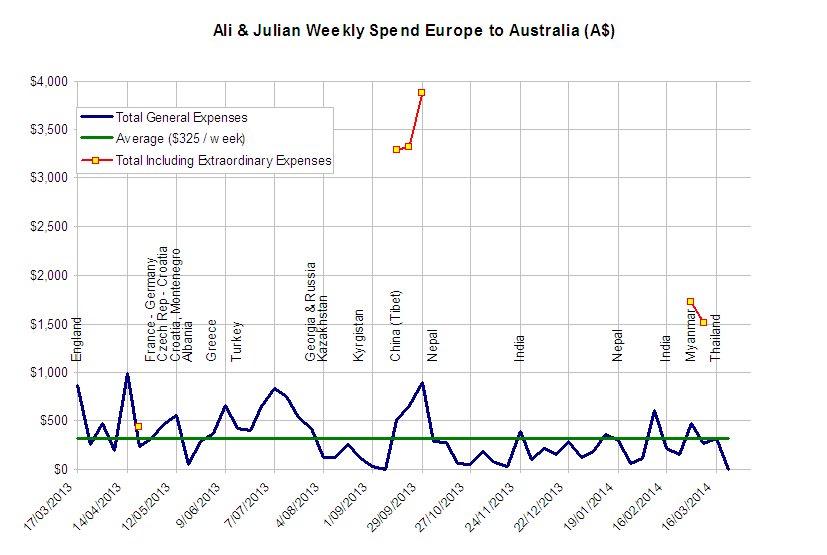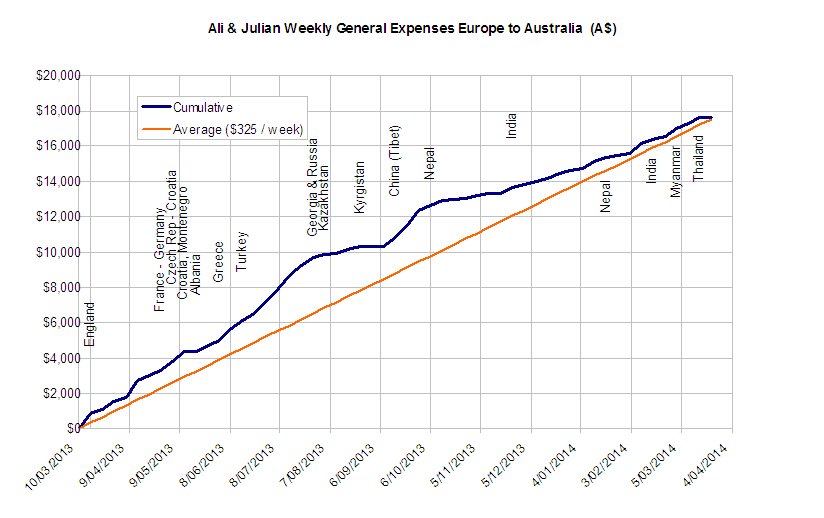Three sections:- Daily Distance, Fuel and Weekly Cost.
Distance and cost charts are in four parts:- Asia to Europe, British Isles and Scandinavia, Europe and Morocco, Europe to Australia.
| Asia-Europe | Top |
| British Isles-Scandinavia | Fuel |
| Europe-Morocco | Weekly Cost |
| Europe-Australia |
We learned a long time ago that more than 300km per day average in a car was a bit too much. If we have a long day we need a day off. 600km is a very long day.
We definitely slowed down towards the North of China. And even more so towards the end of Mongolia. Sped up again in Europe.
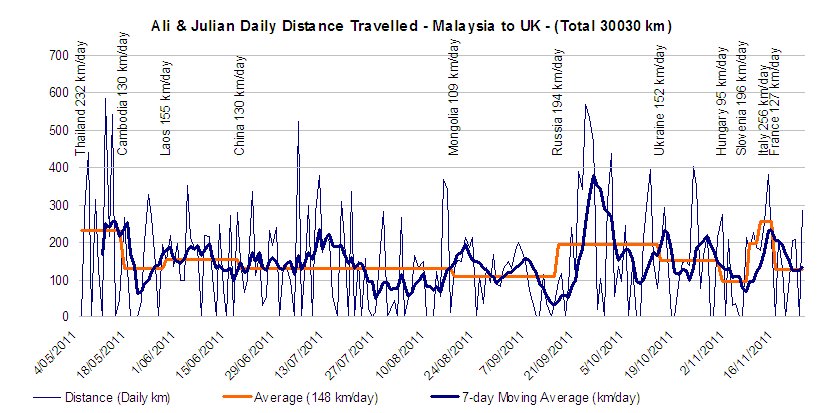
Its really an outcome of the schedule, which has fixed dates for China and length of visa limitations, plus how many detours we feel like making. Otherwise its road condition, on some rough roads its impractical to travel fast.
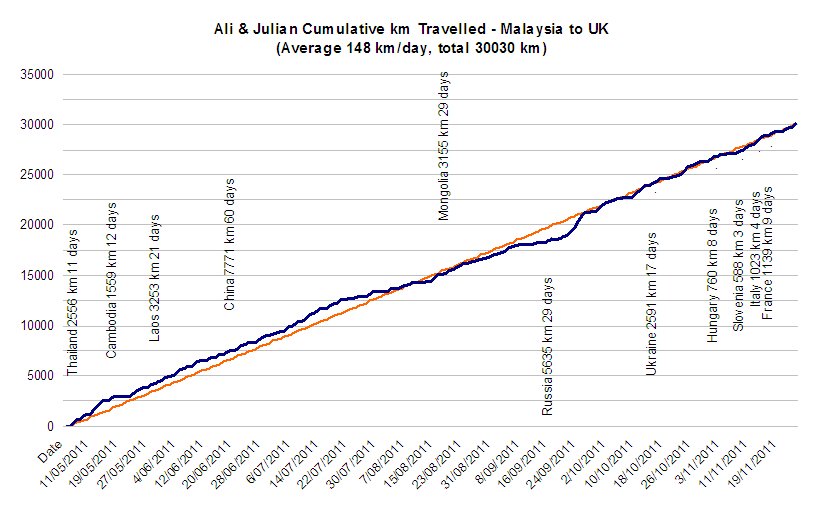
We don't feel particularly rested despite around 25% of days with very little or no travel. A large proportion of them probably involved some sight seeing, particularly in China. In other countries we stop and have "do nothing" days or drive one day and sight see the next. Apart from the middle of China, and the latter part of Mongolia, we haven't been too tired. We managed to slow down a bit when necessary.
Perhaps China was also a little different due to the lack of "attractive" camp sites - this comment is of course written while in Mongolia where camping is so radically different.
We are in Europe in the 2011 off-season. Its essentially closed. We have an Indian Summer but same time last year Europe was under one meter of snow. We feel like we ought to dawdle but conditions seem to be against us.
The distance takes no account of the road condition and speed we were able to maintain but generally our average speed has been well below 70 km/hr. At times its probably been below 25 km/hr over rough roads. Rarely is our maximum speed above 80 km/hr, except for a couple of expressways in China when driving a long way.
Of the three long days of more than 500 km before Mongolia, two were in Thailand where we felt limited by the 15 day visa available for road entry and a long day after Tiger Leaping Gorge where we were retracing our steps.
In retrospect we probably should have better recorded driving time as well as distance.
For the techies. The chart was drawn the hard way (with lots of if statements in a matrix of cells) after finding it totally impossible to work out what the MS Excel Histogram was really counting and to have it provide what I needed..

| Top |
| Asia-Europe |
| Europe-Morocco |
| Europe-Australia |
Our pattern changed once free of visa restrictions and as we met European fuel, food and camping prices. Thus we traveled and ate out less.
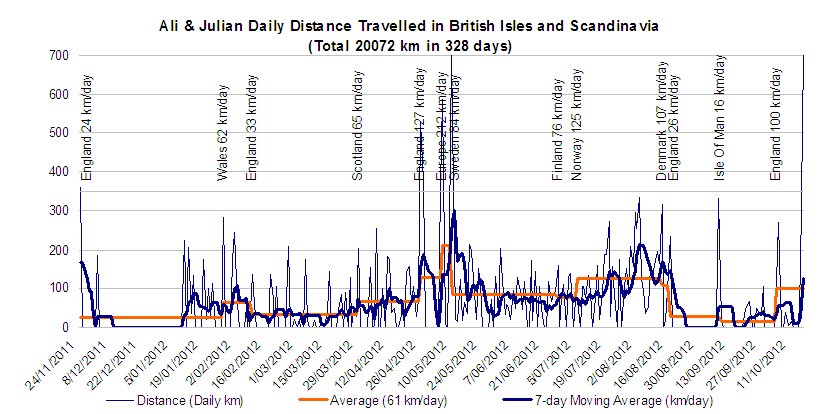
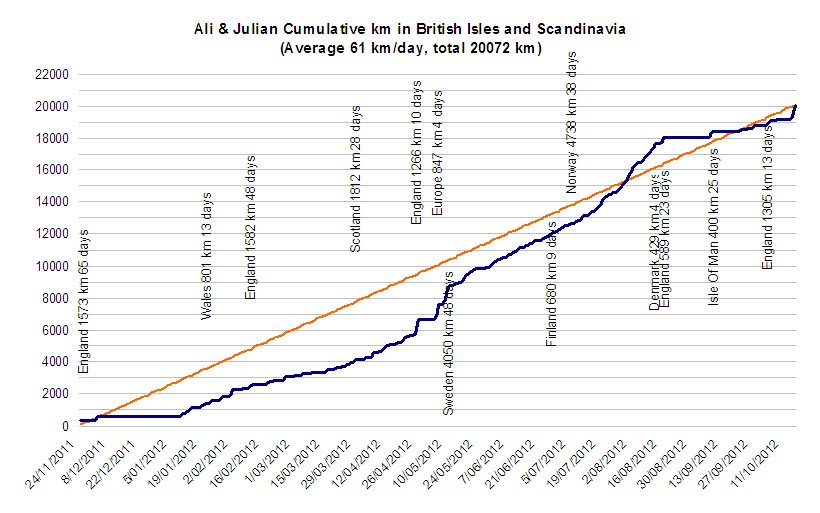
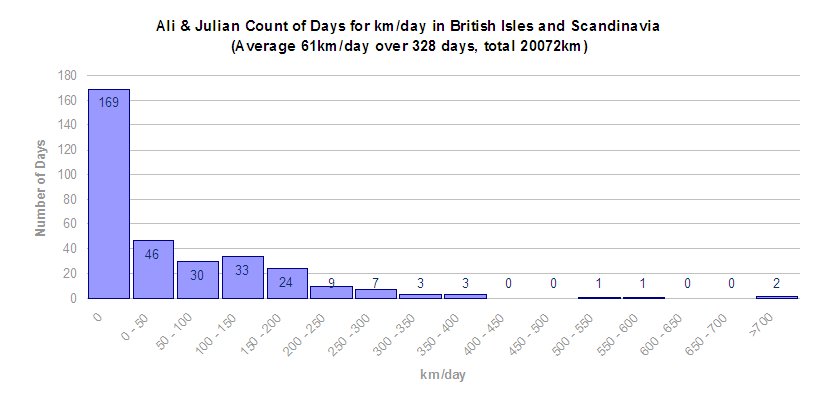
| Top |
| Asia-Europe |
| British Isles-Scandinavia |
| Europe-Australia |
Another change of travel pattern as we head to Morocco for a rest.
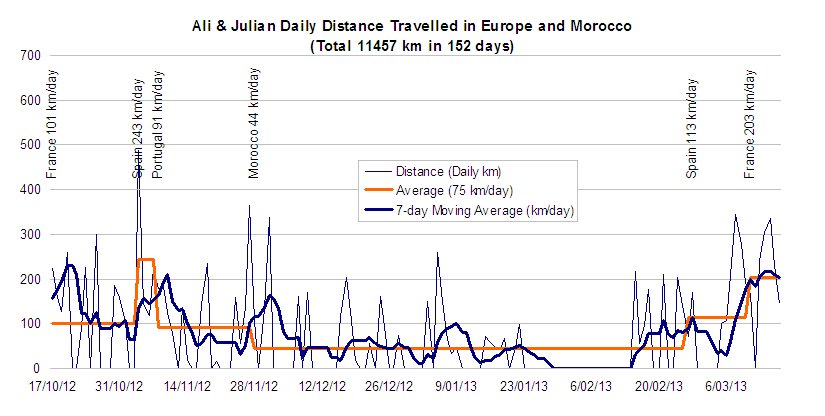
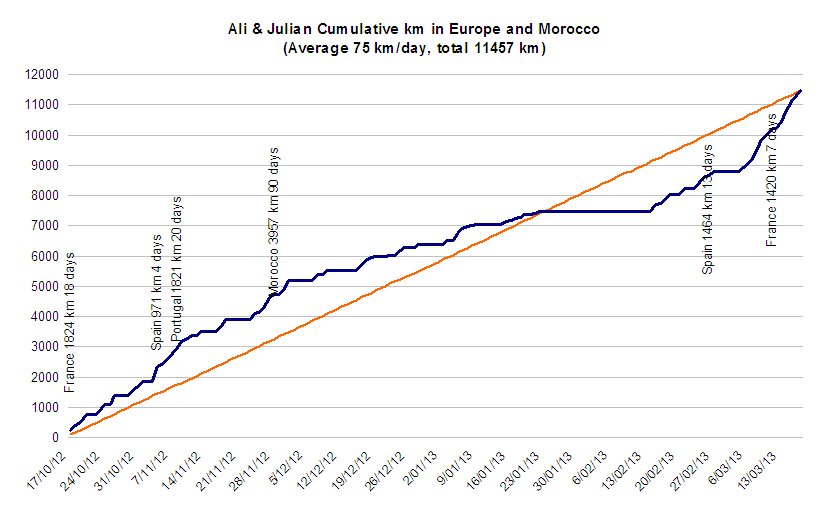
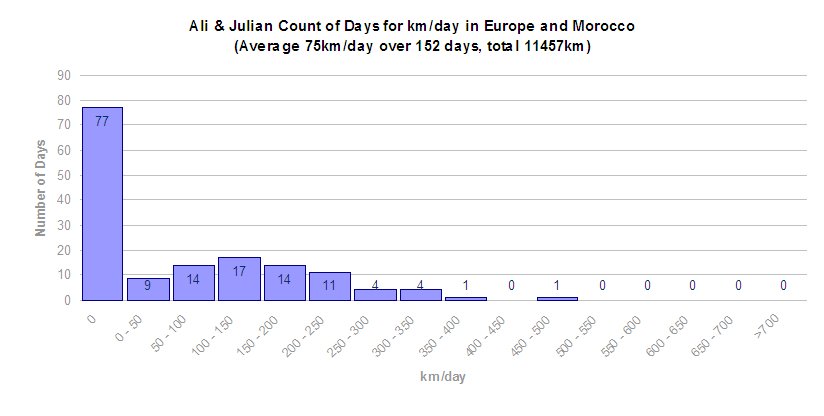
| Top |
| Asia-Europe |
| British Isles-Scandinavia |
| Europe-Morocco |
Turkey was at times rushed due to back tracking for China visa application in Istanbul.
Road conditions through Kazakhstan were particularly trying given the distances involved.
Myanmar was bumpy roads and a convoy schedule. Tibet was a tour schedule on good roads.
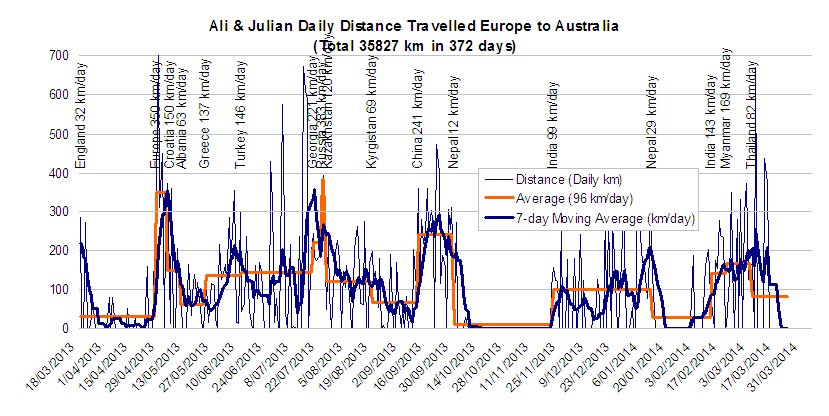
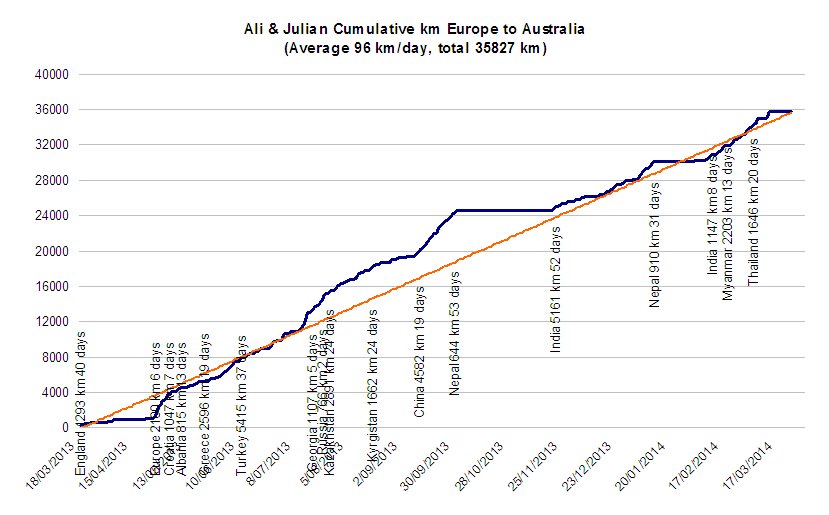
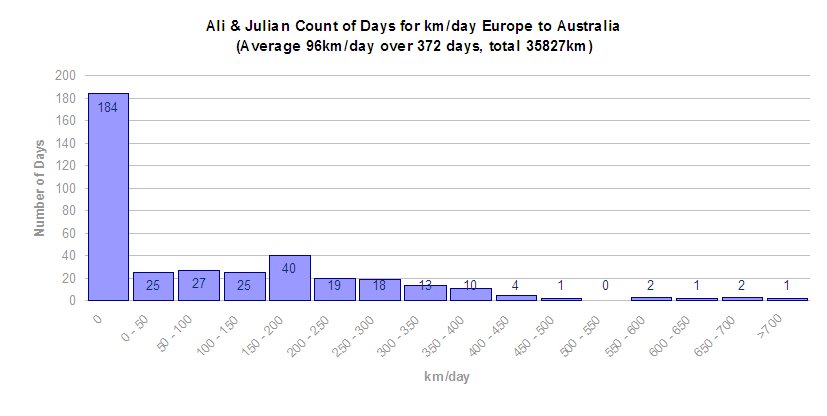
| Consumption and Cost | Top |
| Consumption vs Speed | Daily Distance |
| Price by Country | Weekly Cost |
Fuel consumption is useful to know. If we drive too fast it goes up. It can also be an indication as to the health of the engine and other mechanical bits and pieces.
Also useful for understanding the effect on our budget is A$/100km which depends on fuel consumption, price and exchange rate.
The higher than normal consumption in part of China is probably due to the diesel leak. The two fills after fixing it have distance estimated from gps due to the speedo failure. Diesel leak and speedo both fixed - though speedo is without the ratio adaptor for the large tyres so has a correction (calibrated from gps over long distance). It looks like diesel consumption has returned to normal.
The slow speed across the Gobi in Mongolia meant lower fuel consumption which partly compensated for the higher price. We think tyre pressure changes are also visible in fuel consumption but really haven't recorded sufficient detail. Not sure about the impact of when we locked the front hubs - probably haven't had them locked for long enough.
In Russia payment is made before fuel is pumped. Thus litres/100km is an estimate, I've used the average to date, until the tank can be filled to the top, or run to empty.
Europe is of course simply more expensive. Current European fuel prices can be seen at this website.
In the UK most pumps stop delivering at around 100 litres. We have two 120 litre tanks. This meant that only occasionally were the tanks filled, when I could be bothered walking over to the office to get the pump reset. Health and safety have had a wonderful time. South through France was similar but varying quantity / credit card limits on automated pumps. Cheaper at supermarkets in both countries. The chart sometimes reflects the average over several fills.
The fuel consumption increase in Morocco is hopefully due to driving in sand and rough roads. Just in case cleaned the air filter.
Fuel consumption increase in Turkey is probably due to exhaust flapper sticking, high speeds on good roads and lots of long steep mountain climbs. Consumption has reduced in Georgia, Russia and Kazakhstan. From as high as 20 litres/100km in Turkey to less than 15 litres/100km in Kazakhstan. Consistent with the speed vs consumption estimate below.
The effect of using diesel for cooking and heating is negligible / unmeasurable though it obviously has an effect.

| Top |
| Consumption and Cost |
| Price by Country |
Having said that we can notice a difference between the same average speed on motorways and other roads where the occasional roundabout or other obstruction causes deceleration/acceleration.
We have also recognised the difference between driving slowly on roads in Norway and sand in Morocco. The "stickier" sand raised the fuel consumption.
I suspect that the real curve measured on a dynamometer would be a bit steeper to the right but its a tad difficult to maintain an average speed of 100 km/hr to find out. And a bit flatter to the left, though we get a bit impatient at 20 km/hr for too long.
The value of this chart is probably having a guestimate of range for a full tank. The furthest we've traveled with two full tanks and a reasonable safety margin is 1600km in Australia over dirt roads.
As mentioned above, the $/100km is an outcome of average speed, road conditions (surface, straightness, hilliness, etc.), and fuel price.
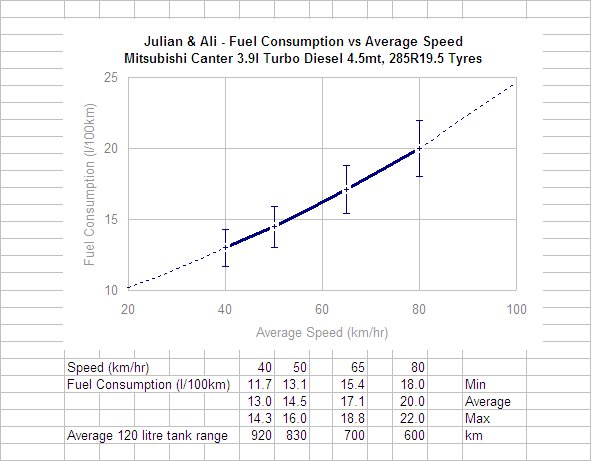
| Top |
| Consumption and Cost |
| Consumption vs Speed |
| Country | Number of Fills | Currency | Cost/litre | A$/litre | Name | Pump Colour | |||||
| Malaysia | 1 | RMB | 1.8 | $0.56 | blue | ||||||
| Thailand | 5 | Baht | 30.3 - 31.5 | $1.01 - $1.05 | dsel | blue | |||||
| Cambodia | 4 | US$ | 1.06 - 1.17 | $1.01 - $1.12 | blue | ||||||
| Laos | 6 | Kip | 9600 - 10450 | $1.13 - $1.23 | diesel | blue | |||||
| More expensive in the South | |||||||||||
| China | 12 | RMB | 7.33 - 7.63 | $1.06 - $1.12 | chaiyou | ||||||
|
Pumps show octane, like 93#, 97#. Diesel is 0# |
|||||||||||
| 1 | RMB | 8.18 | $1.20 | chaiyou (cold weather) | |||||||
| Last fill before Mongolia. | |||||||||||
| Mongolia | 5 | Togrog | 1650 - 1880 - 2020 | $1.31 - $1.48 - $1.59 | diesel | ||||||
|
More expensive at the Southern border. Cheapest around Ulaan Bataar (our first fill at T1650) |
|||||||||||
|
Octane shown as #0 like China. Also Cyrillic "D" and "T". Thus "ДТ"). |
|||||||||||
| Russia | 7 | Rouble | 22.00 - 26.50 | $0.69 - $0.85 | diesel | ||||||
|
Same pump signage as Mongolia. Hence - "ДТ" |
|||||||||||
|
More expensive towards Mongolian border. |
|||||||||||
|
Different grades. "EURO" seems to be more expensive. We're not quite sure what the grades are and its sometimes unclear what is being sold. |
|||||||||||
|
Euro grade seems to be around R24.80 per liter. We filled mostly with Euro grade. |
|||||||||||
| Ukraine | 3 | Hryvnia | 9.30 - 9.80 | $1.17 - $1.23 | Diesel | ||||||
|
Same pump signage as Mongolia. Hence - "ДТ" also - "Дn" |
|||||||||||
|
Not the same attention to grades. Near the Hungarian border it seemed to separate into "Euro" and "TIR". |
|||||||||||
| Hungary | 1 | Forint | 437.9 | $1.88 | Diesel | ||||||
|
Just "diesel". |
|||||||||||
| Slovenia | 0 | ||||||||||
| Italy | 1 | Euro | 1.531 | $2.04 | Diesel | ||||||
|
Ironically no mention of "Euro Diesel" as we saw in Russia. |
|||||||||||
| France | 2 | Euro | 1.49 - 1.51 | $1.99 - $2.01 | Premium Diesel | Black | |||||
|
Near Swiss / Italian borders |
|||||||||||
| 4 | 1.35 - 1.39 | $1.79 - $1.85 | Gazole | Black | |||||||
|
Not sure if tax involved in labeling of pumps for "trucks" and "cars". |
|||||||||||
|
Automated pumps limit quantity / credit card. Hard to fill tank. |
|||||||||||
| British Isles (England, Wales, Scotland, Isle Of Man) | 14 | Pounds | 1.39 - 1.49 | $2.11 - $2.26 | Diesel | Black | |||||
|
Became more expensive as we traveled and further north. |
|||||||||||
|
Isle Of Man was GBP1.49. Probably most expensive on our trip. |
|||||||||||
| Germany | 1 | Euro | 1.49 | $1.99 | Diesel | Black | |||||
|
Cheaper off the autobahns. |
|||||||||||
| Denmark | 2 | Danish Kroner | 11.09 - 11.72 | $1.92 - $2.03 | Diesel | Black | |||||
| Sweden | 5 | Swedish Kroner | 14.03 - 14.64 | $2.00 - $2.09 | Diesel | Black | |||||
| Finland | 2 | Euro | 1.56 - 1.64 | $2.08 - $2.19 | Diesel | Black | |||||
|
Expensive at Utsjoki before Norway border, better a few km east on Finnish side of River Tana |
|||||||||||
| Norway | 4 | Norwegian Kroner | 13.29 - 13.65 | $2.16 - $2.22 | Diesel | Black | |||||
|
Full tanks on arrival, empty tanks on departure! |
|||||||||||
| Spain | 2 | Euro | 1.339 | $1.78 | Gazoleo | Black | |||||
|
Pump attendant in North. We were lucky and filled both tanks. Generally more expensive. |
|||||||||||
| Portugal | 1 | Euro | 1.399 | $1.87 | Gazoleo | Black | |||||
|
Prices not routinely advertised. |
|||||||||||
| Morocco | 6 | Dirham | 8.34 - 8.50 | $0.93 - $0.95 | Diesel | Black | |||||
| Andorra | 1 | Euro | 1.19 | $1.49 | Diesel | Black | |||||
| Czech Republic | 1 | Czech Crowns | 34.7 | $1.73 | Diesel | Black | |||||
| Montenegro | 2 | Euro | 1.22 | $1.52 | Diesel | Black | |||||
| Albania | 1 | Lek | 1.19 | $1.49 | Diesel | Black | |||||
| Greece | 4 | Euro | 1.30 - 1.40 | $1.62 - $1.75 | Diesel | Black | |||||
| Turkey | 8 | Turkish Lira | 3.77 - 4.23 | $2.11 - $2.37 | Motorin or Euro Diesel | Black | |||||
| Prices
seem to be in two brackets. Around 4.2 and around 3.9. For both Euro
Diesel and Motorin. In 2011 Turkey reportedly switched to low
sulphur so all diesel is the same. However, we've also seen reports
of better fuel consumption from higher priced fuel. But no data. Our
consumption is higher than most countries (but that may be due to
exhaust flapper sticking and a lot of higher speed driving on good
roads and lots of steep mountains). Its confused us because "Euro Diesel" also refers
to the pump nozzle required to fit some vehicles designed to run on
low sulphur Euro Diesel - thus two pumps at the same station with
the same price, one marked Motorin the other Euro Diesel.
The pumps have elaborate computer systems attached and have attendants who are good at pressing buttons and swiping their cards. We have been asked occasionally for "fische", which we think is some sort of ticket we don't have. Our registration number is recorded at the pump but we don't know why. |
|||||||||||
| Georgia | 1 | Georgian Lari | 2.00 | $1.32 | Diesel or Euro Diesel | Black or Yellow | |||||
| Kazakhstan | 6 | Kazakhstan Tenge | 97 - 102 | $0.68 - $0.72 | Diesel | Black | |||||
| Kirgyzstan | 2 | Som | 39.9 - 43.5 | $0.81 - $0.88 | Diesel | Black | |||||
| China (Tibet) | 6 | RMB | 7.2 - 9.5 | $1.26 - $1.67 | chaiyou | ||||||
| Nepal | 2 | Nepal Rupees | 102 - 103 | $1.12 - $1.13 | diesel | ||||||
| India | 10 | Indian Rupees | 52.9 - 60.2 | $0.95 - $1.08 | diesel | ||||||
| Myanmar | 3 | Kyat | 990 - 1034 | $1.16 - $1.22 | simple diesel (or premium) | ||||||
| Thailand | |||||||||||
Exchange rates have changed while we've been traveling. Up by 10% (Aus dollar improves) and down by 10%.
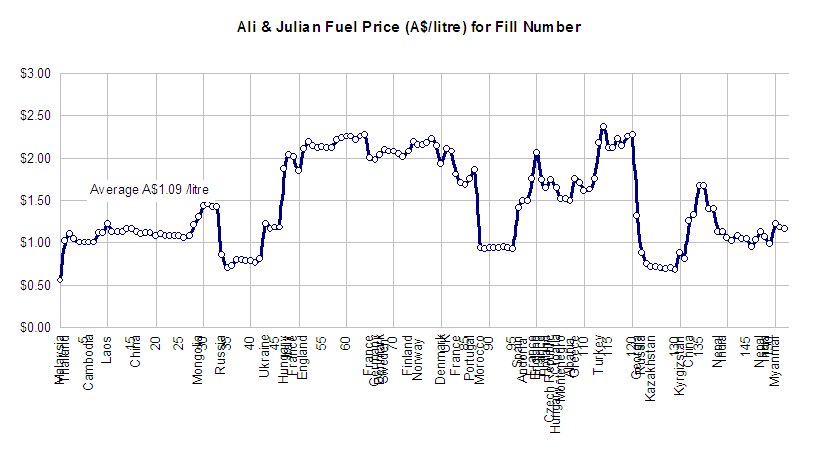
| British Isles-Scandinavia | |
| Europe-Morocco | |
| Europe-Australia |
General expenses are the day to day living, transport, camping and entertainment. Controllable to some extent. Extraordinary is things like shipping, hotel and other setup costs in Malaysia, the solar regulator, oil change, truck repairs and tyres, and the Chinese agency costs.
By a quirk of maths the longer we travel the lower the $/week for shipping, though of course the $ doesn't change.

And the weekly cost. Just to exercise some sort of control. We have a vague idea of budget but don't feel constrained. After 12 months we are well and truly under budget.
Philosophically, cost is an outcome of how we approach the trip rather than trying to squeeze ourselves into a budget. Just like any good management accountant, if we wanted a different cost outcome we'd have to do something differently. Cost is really an indicator of how well, or poorly, other things are working. For the management, and other, accountants that don't accept or comprehend that I can recommend reading "Relevance Lost".
We have a detailed break down but really haven't had to look too closely at it.
Fuel costs are about 50%. The last high week in China we filled up 3 times instead of the previous 1 or 2 times per week. The low week in China has only one fuel fill and a couple of rest days. If we have to fill up more than twice in a week, or more than three times in two weeks we think we are traveling too fast.
Food (eating out and in) is about 20%. We stocked up on food in China before Mongolia in the expectation that some things we like wouldn't be available (like Orange Juice, Cow's Milk, margarine, chicken and steak, etc.). Apart from the supermarkets of Ulaan Bataar we were basically correct. The low cost of Mongolia reflects feeding ourselves and camping wherever we could - not to save money per se, just because that's how we like it.
We aren't tea total but have found that alcohol exacerbates a headache problem. This trip is challenging enough without any complications of alcohol so we've been substantially booze free. A bit hard in Portugal with wine around A$2 per bottle.
In Europe we see higher fuel prices, significant road tolls in Slovenia and Italy though mostly avoided elsewhere by using minor roads, and camping ground costs have begun to have an impact. Having said that we've free camped in Scotland, Scandinavia, Spain and Portugal while using Aires in France.
Slightly confusing, the weeks start on Sunday and end on Saturday but none of our border crossings occurred on Saturday or Sunday so some weeks have costs from two countries.
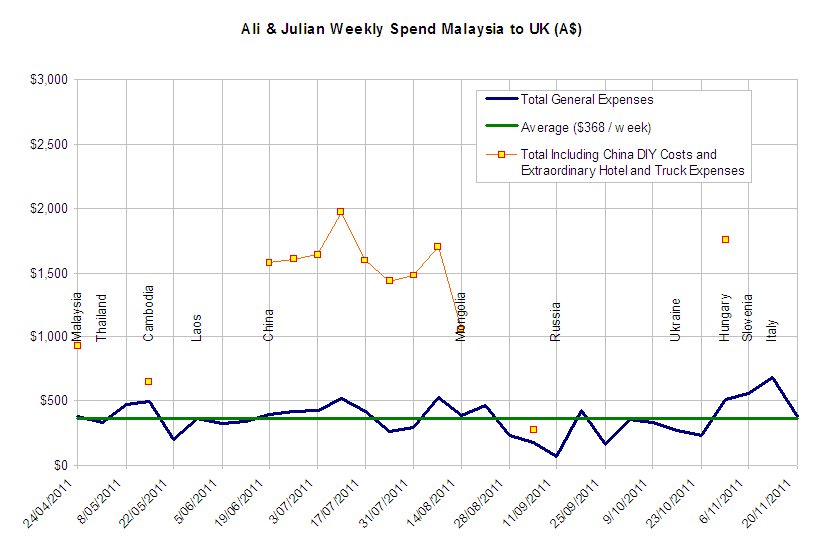

| Top |
| Asia-Europe |
| Europe-Morocco |
| Europe-Australia |
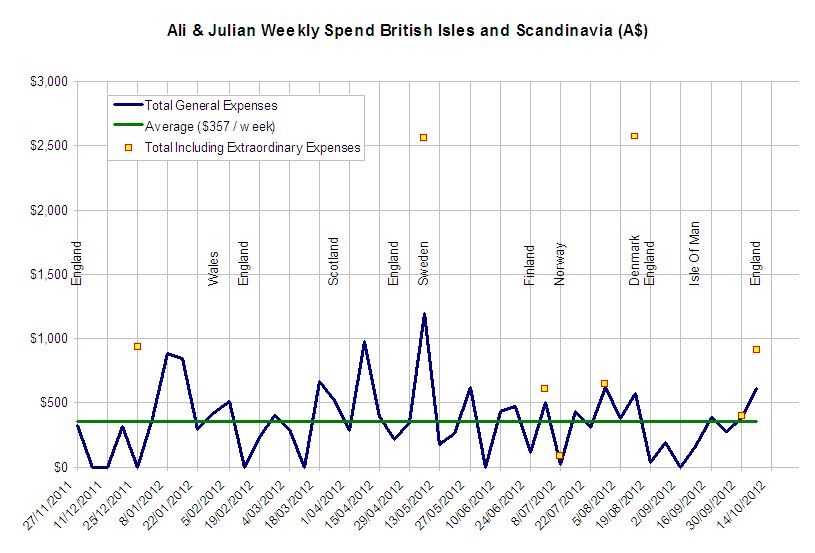
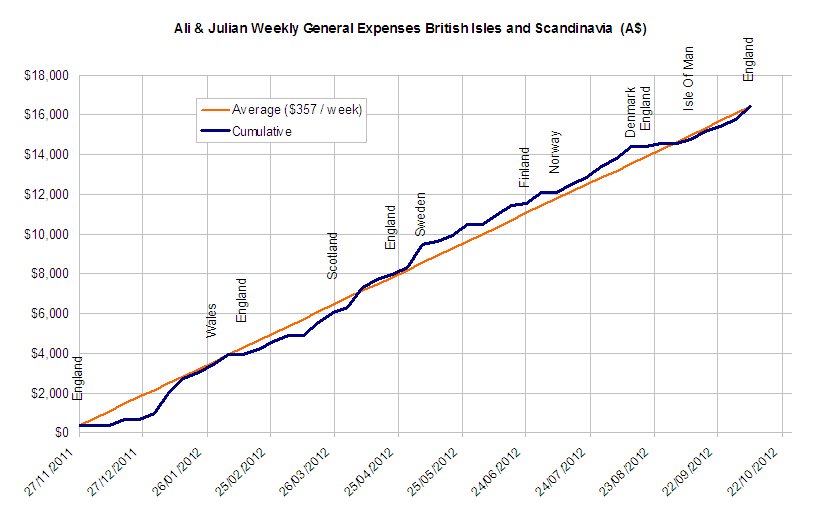
| Top |
| Asia-Europe |
| British Isles-Scandinavia |
| Europe-Australia |
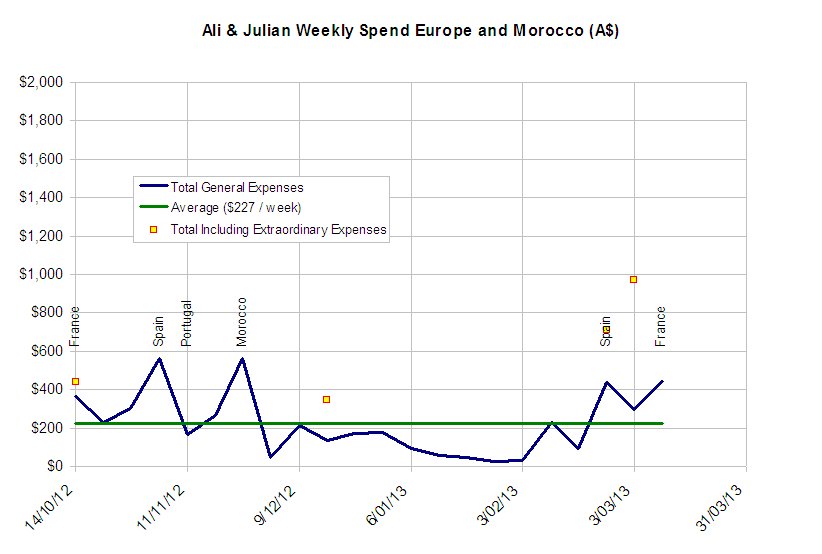
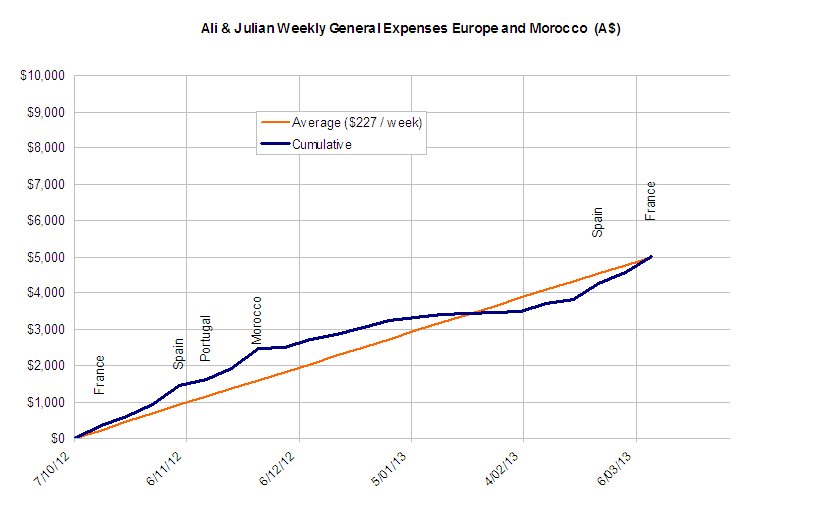
| Top |
| Asia-Europe |
| British Isles-Scandinavia |
| Europe-Morocco |
